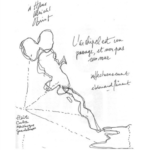When people (e.g. youth) meet informally in the public space, they physically occupy this space. This appropriation is visible for others and has an influence on them, especially on people, who would potentially use this space too. Or on people, who see kind of a threat in either the gathering of a group of (young)…
Month: March 2020
epistemic thing, examples, object perspectives
epistemic thing – example
Paulo de Assis about the epistemic thing in musical performance: “If we require the performance to be an idealized act of interpretation … we take away the possibility for epistemic things to emerge or to unfold into unforeseen dimensions … If we want to give credibility to performance as an instance, among others, of epistemic…
(inter)personal perspectives, actor constellation, concepts
actor constellation

If an actor were dealing exclusively with a natural or otherwise given environment, then a complete description of that actor’s perceptions, preferences and capabilities would allow us to infer the course of action that likely to be chosen – and a complete description of the environment and its casual laws would allow us to predict…
(inter)personal perspectives, concepts, informed dissent / proactive idiocy
informed dissent / proactive idiocy
Initial definition: The concept of proactive idiocy is one that acknowledges the openness and unpredictability of everyday objects and their potential to trigger reflection in the researcher. When objects “misbehave” – when they behave unexpectedly – they can be understood as being an “idiot object.” In Speculative Design, the “idiot object” can be used as…
concepts, crossmapping, hybrid fora, spatial perspective, third space
crossmapping
Crossmapping superimposes item A onto item B and item B onto item A, revealing a bidirectional relationship between the two items. These “items” can be virtually anything: works from different disciplines (transmedial), works from the same disciplines and across different time periods (transhistorical), ecosystems across different continents (transpatial), people from different cultures (transcultural), etc. By…
concepts, nomadic concepts, spatial perspective, traveling concepts
traveling concepts
Nomadic concepts – also and perhaps better known as “travelling concepts” – are a heuristic tool and analytical practice for communicating across disciplinary, professional and cultural boundaries through discussing and opposing different understandings and uses of concepts such as identity, space or emotion. It could thus also be called a translation tool. It was first…
concepts, nomadic concepts, spatial perspective, traveling concepts
nomadic concepts
Knowledge + History + Society + Culture = Concepts If we think why nomadic concepts tool is so important, it could be said that it brings a critical awareness to the researcher in terms of inter- and transdisciplinary perspective. The concepts have specific meanings and the bring knowledge from other disciplines, professions and cultures. As…
concepts, experimental system, spatial perspective
experimental system
Experimental system is the small functional part of a research. The aim of having it is to answer specific questions related to the research. Although it brings answers, it asks also new questions and therefore they causes an ‘inconcludable game’. It is also mentioned that an experiment must always give an undiscovered outcome or something…
concepts, hybrid fora, spatial perspective
hybrid fora
The concept of hybrid forums is closely linked to the theory of the third space by Homi K. Bhabha. In this theory, Bhabha designs the third space as a place of constant exchange and negotiation of cultural phenomena. Thus, the attempt to interpret cultural identity becomes an endless transformative process that leads to the dissolution…
concepts, spatial perspective, third space, trading zones, transaction spaces
transaction spaces
‘Practiced places’ (which can be fluid) where different knowledge producers come together. Ideally, these must be “safe spaces,” which are shared, open, autonomous, dynamic, reflective, and allow room for unpredictability. Resource: Transdisciplinary Research and Practice for Sustainability Outcomes | Dena Fam, Jane Palmer, Chris Riedy, Cynthia Mitchell
boundary object, concepts, object perspectives
boundary object

boundary objects Sabine Maasen schreibt in ihrem Essay “Collaborating In and Beyond Science — Obstacles and (Somewhat Surprising) Opportunities” über boundary objects: “A boundary object is both a product and a mediator of multiple interaction needed enable productive cooperation among various social worlds without taking away their differences in perspective.” Bei dieser Beschreibung musste ich an…
agential realism, concepts, object perspectives, string figures / speculative fabulation
SF: string figures / speculative fabulation
v. 1.2 The concept of string figures is introduced in: Donna Jeanne Haraway, Staying with the Trouble: Making Kin in the Chthulucene, Experimental Futures: Technological Lives, Scientific Arts, Anthropological Voices (Durham: Duke University Press, 2016). If not mentioned otherwise, the references and quotes in this post are referencing above publication. Bold and italic font-styles in…
concepts, epistemic thing, object perspectives
epistemic thing
The “epistemic thing” is the object of investigation during the research process, which can develop to become a “technical object” over the course of the investigation, therefore becoming something that can be used to research other “epistemic things”. The boundary between “epistemic thing” and “technical object” is not static and identifying something as either or…
concepts, spatial perspective, trading zones
trading zones
According to Galison, “Two groups can agree on rules of exchange even if they ascribe utterly different significance to the objects being exchanged; they may even disagree on the meaning of the exchange process itself. Nonetheless, the trading partners can hammer out a local coordination, despite vast global differences. In an even more sophisticated way,…